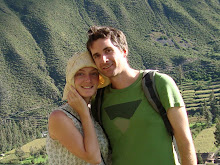
From there, we headed through the bustling and pretty northern city of Ocotal and on via a workshop selling disappointingly garish and ugly ceramics to Ciudad Antigua, a very peaceful town down a dirt track.  The street sign on this sweet little house states that 'AQUI FUE CALLE' or 'HERE WAS A STREET'.
The street sign on this sweet little house states that 'AQUI FUE CALLE' or 'HERE WAS A STREET'.
 The street sign on this sweet little house states that 'AQUI FUE CALLE' or 'HERE WAS A STREET'.
The street sign on this sweet little house states that 'AQUI FUE CALLE' or 'HERE WAS A STREET'.The town was one of the first established in these parts and was famously raided by English pirate Henry Morgan in the 17th century. Ciudad Antigua is nowhere near the sea, but Henry made it here after by navigating a long way up Central America's longest river, the Rio Coco, from the Caribbean. He was one of the most brutal and successful pirates with raids in Mexico, Cuba, Jamaica, Panama, Nicaragua and Venezuela earning him the nickname 'Morgan The Terrible'.
 Having a hire car enabled us to get to places not many tourists can easily reach. In fact, as the above photo shows, it got us to places where hardly any cars actually go either. We passed one bus and one pick-up truck the whole time we were there.
Having a hire car enabled us to get to places not many tourists can easily reach. In fact, as the above photo shows, it got us to places where hardly any cars actually go either. We passed one bus and one pick-up truck the whole time we were there.Next, we travelled further north into the foothills of the Segovian mountains and spent the night in the town of Jalapa, which had more roadworks and deep, muddy diversions to challenge our little car, than anything else going on. It's famous for a huge food festival of maize every September, but other than that it seems to remain sleepy. The next day, we took the car on a ridiculously bumpy, stony, muddy uphill mountain track to a place called Finca Cerro Jesus or 'Jesus Mountain', a stone's throw from the Honduran border.  We went on a challenging trek through coffee plants and lush cloud forest to reach a couple of pretty waterfalls and some breathtaking views. Afterwards, we got our energy levels back up with a tasty lunch in the coffee farm workers' canteen.
We went on a challenging trek through coffee plants and lush cloud forest to reach a couple of pretty waterfalls and some breathtaking views. Afterwards, we got our energy levels back up with a tasty lunch in the coffee farm workers' canteen. 
 We went on a challenging trek through coffee plants and lush cloud forest to reach a couple of pretty waterfalls and some breathtaking views. Afterwards, we got our energy levels back up with a tasty lunch in the coffee farm workers' canteen.
We went on a challenging trek through coffee plants and lush cloud forest to reach a couple of pretty waterfalls and some breathtaking views. Afterwards, we got our energy levels back up with a tasty lunch in the coffee farm workers' canteen. 
It would have been worth the effort alone for the road journeys in this beautiful part of Nicaragua, formerly a stronghold of Sandino's army in the 1930s and later in the 1980s, witness to some of the most fierce fighting between the army and the CIA-funded Contras, of which so many farming families were victims. But the walk really gave us chance to appreciate it all.



No comments:
Post a Comment